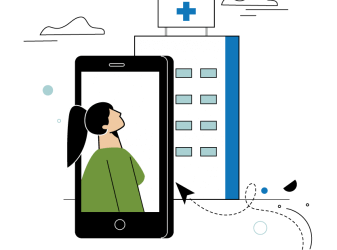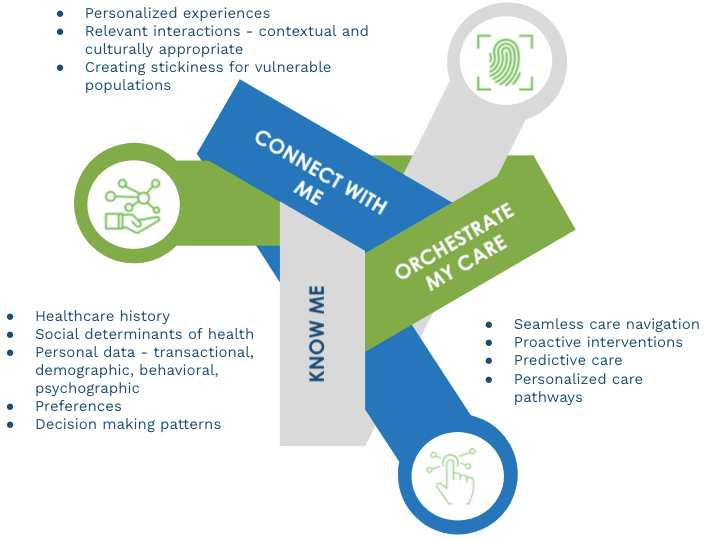
Consumer interactions: Improve the patient experience in healthcare with text and chat
Betsy Hansen, Director, Center of Consumerism, AVIA
Insights
Sonia Singh, Vice President, Center for Consumerism, AVIA

For many consumers, navigating their healthcare journey can feel convoluted and overwhelming. From outdated technology to poor communication to generalized care, consumers are not receiving the personalized, streamlined experiences they have come to expect through their interactions with other industries. Compare the average healthcare experience to Spotify, which curates personalized music recommendations, or Care/of and Curology, which provide customers with tailored, customized health products that address their unique needs. Healthcare is clearly lagging behind other industries – studies found that 62% of healthcare consumers say the healthcare experience feels like it is purposefully set up to be confusing, and 54% of patients feel their healthcare providers don’t have all the contextual information needed to personalize healthcare recommendations.
62% of healthcare consumers say the healthcare experience feels like it is purposefully set up to be confusing.
Many health systems know very little about a patient. Do patients prefer appointments at a certain time? Do they have transportation challenges? Have they called the access center multiple times with the same issue? What social determinants of health exist in their lives that may be compounding their health care needs? This lack of data and personalization is causing patients to search for care elsewhere: about 7% of consumers switch healthcare providers because of poor experience, translating to an average of at least $100 million in revenue losses per hospital annually.
Health systems need to start treating the patient as the individual they are in order to increase loyalty, improve care, and prevent revenue losses. If not, they risk losing market share and being left behind in an increasingly digital world. To emerge as leaders in the industry, more health systems have been leaning into hyper-personalized care enabled by digital to drive growth and enhance the patient experience.
Health systems that aim to create hyper-personalized experiences collect, compile, and analyze consumer data to develop an “n-of-1” view of each patient. This view looks at each patient as an individual, not just as a part of a segment or population, and provides a longitudinal, 360° view of the consumer. By building this strong data foundation, health systems can provide patients and consumers with communications and marketing customized to their unique needs. At the highest level, this data foundation can be used for proactive care interventions and personalizing care plans.
For health systems looking to integrate hyper-personalized infrastructure into their consumer experiences, it can be helpful to break it down into four tiers, starting with basic data and moving to advanced, AI-powered insights:
As health systems start creating hyper-personalized care programs, three interconnected building blocks should be at the center of a hyper-personalized care infrastructure. Together, these three building blocks create an “n-of-1” experience for the consumer and enable health systems to advance through the tiers listed above.

The first building block is centered around understanding the consumer across data points. The goal is to create a data architecture that allows health systems to view the patient as an individual, not just as a generic segment of the population. Health systems should strive to collect transactional, demographic, behavioral, and psychographic data, as well as information around healthcare history, social determinants of health, communication preferences, decision-making patterns, perceptions about healthcare, and more.
Questions to ask:
The second building block is designed to help create a consumer-facing experience that is tailored to each individual’s unique preferences to improve engagement with the health system. The aim is to use “Know Me” data architecture to recognize individual patients’ care needs and activate engagement with the health system.
Health systems that successfully connect with patients create personalized digital experiences, starting at the digital front door and extending through care coordination, bill payment, and follow-ups. Every interaction is relevant, contextual, and culturally appropriate, providing the consumer with an experience that feels designed just for them and their unique care needs.
Questions to ask:
Beyond tailored communications, data architecture and patient preferences can be used to personalize and orchestrate care touch points to improve outcomes, promote continued wellness, and increase loyalty. The goals of this building block are to provide seamless care navigation, offer proactive interventions to reduce acute care needs and emergency department admissions, predict and address a patient’s care needs, and create personalized care pathways designed for the patient’s unique health needs.
Questions to ask:
While introducing any tier of hyper-personal care to consumers can have positive effects on patient loyalty and health outcomes, health systems that strive to be leaders should look to infuse data and communication practices at the enterprise level. An organization operating at the highest level of hyper-personalized care could have:
If your health system wants to emerge as a true leader in healthcare while driving revenue and revolutionizing the patient experience, it’s time to start exploring hyper-personalized care. Whether you’re just starting your digital personalization journey or are on your way to advanced hyper-personalization, AVIA is here to help. The experts at AVIA’s Center for Consumerism have partnered with health systems across the country to guide them through integrating hyper-personalized care into their organization. To learn more, talk to an expert today.